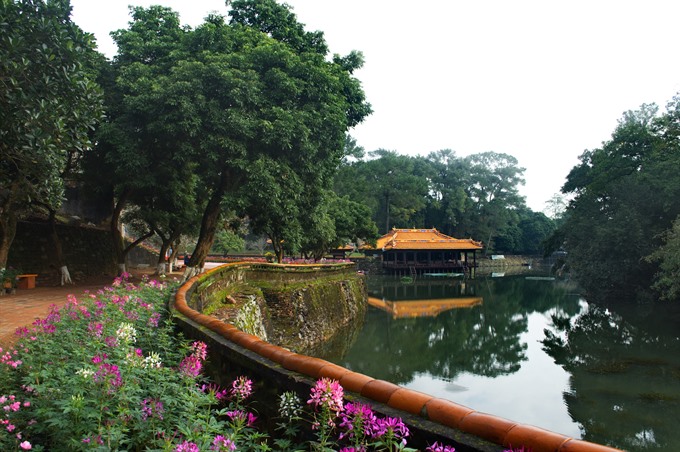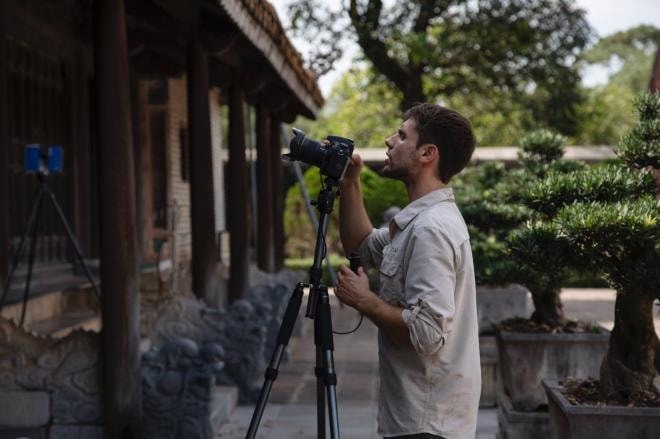 Features
Features

As part of a project to preserve its most famous ancient buildings, the city of Huế is partnering up with two American technology firms who will apply advanced computer imaging techniques and data storage to help bring the country’s past to life.
 |
| Peaceful: View of Tự Đức Mausoleum from the entrance gate. VNS Photo Nguyễn Văn Sum |
As part of a project to preserve its most famous ancient buildings, the city of Huế is partnering up with two American technology firms who will apply advanced computer imaging techniques and data storage to help bring the country’s past to life. Huê Phong reports.
THỪA THIÊN-HUẾ — The former imperial city of Huế is applying 3D technology in conservation in an attempt to more accurately restore the structures built by the Nguyễn Dynasty (1802-1945).
According to the Huế Monuments Conservation Centre, a local government body that manages all relics related to the dynasty, the pilot project will be used for two relic sites – the An Định Palace and the mausoleum designated for the dynasty’s fourth king Tự Đức.
The centre is working with CyArk and Seagate Technology PLC, two partners from the US, to undertake the work.
CyArk, headquartered in Oakland, California, is a non-profit organisation founded in 2003 that works in digitally recording, archiving and sharing global cultural heritage. It has recorded over 200 monuments in 40 countries around the world.
Seagate Technology, headquartered in Cupertino, California, is an expert in data storage.
Phan Thanh Hải, the centre’s director said the results of the project would be processed and stored to create 3D models of the relics. “Those would be helpful for the research and restoration of the relics in terms of architectural accuracy,” he said.
“The project is also significant in raising awareness on the values of world cultural heritage as well as conservation work.”
Beginning in June following a decision by the local government of Thừa Thiên-Huế Province, staff from CyArk have captured photos of the relics, using drones and lidar.
In the next step, CyArk will use the photos to create 3D models and plans for the conservation centre.
According to John Risterski of CyArk, the organisation was honoured to be working on the conservation of Tự Đức Mausoleum, which is an important complex in the city’s heritage system.
Meanwhile, Seagate Technology pledged to assist CyArk, both in field work and desk work. The company will supply high performance hard disks, including USB-C LaCie® Rugged® Thunderbolt, 2big Dock Thunderbolt 3, SSD Nytro®, and BarraCuda® Pro 10TB.
834123923PM.JPG) |
| Historic: The stone stele house in Tự Đức Mausoleum. VNS Photo Nguyễn Văn Sum |
 |
| A member of CyArk staff takes photos of the relics. Photo courtesy of the Huế Monuments Conservation Centre. |
Robert Yang of Seagate Technology said the company would ensure the best storage solutions for the photos and 3D models for use today and in the future.
The data would also be used to create virtual reality tours for visitors to the sites.
Since 2003, CyArk has succeeded with similar projects at the holy Thai temple Wat Phra Si Sanphet, the Cambodian temple complex Angkor Wat, and Australia’s Sydney Opera House.
An Định Palace and Tự Đức Mausoleum are both listed as part of the Huế complex of monuments recognised as a world cultural heritage by the UN cultural agency UNESCO in 1993.
Originally, An Định was a separate palace built on the southern bank of the Hương (Perfume) River for the prince who later became Khải Định (1916-1925), the 12th king of the dynasty. It was later the home for the king’s mother Từ Cung.
Today it is a popular site for visitors, and is famous for its murals.
Tự Đức Mausoleum, located on a hill near the riverbank, is one of the most beautiful of its kind in the city. The mausoleum was designed in harmony with nature and the natural topography of the hill.
Tự Đức (1847-83), who was the fourth king of the dynasty and had no son, built the mausoleum for himself. This was in contrast to other kings, whose resting places were built by their sons after their deaths as a form of memorial. — VNS




